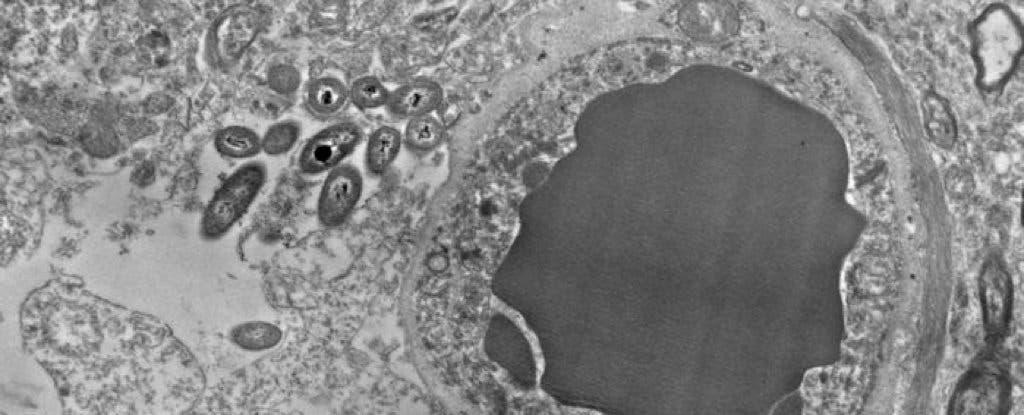A new study suggests that bacteria might be making a home in the unlikeliest of places: the human brain.
The brain is one of the most well-protected organs of the human body, suspended in cerebrospinal fluid, and isolated from the bloodstream by the blood–brain barrier. The blood-brain barrier in particular acts effectively to protect the brain from circulating pathogens and is the reason why blood-borne brain infections are very rare (though not impossible). Simply put, the brain is a fortress.
That’s why, of all places in the human body, the brain is the last part you’d expect to find any bacteria in — yet this is exactly what a new study reports. Scientists from the University of Alabama in Birmingham (UAB) told the audience at the annual meeting of the Society for Neuroscience about a tentative finding: gut bacteria in the brain.
“The gut-brain microbiome has received an abundance of attention recently,” the abstract reads. “It is thought that gut microbiota can influence brain function and behavior, but how that happens is still unknown. It has been proposed that bacteria can enter the brain through the blood-brain barrier, and/or via nerves that innervate the gut.”
The gut microbiome has indeed been shown to play a much more important role ,than we expected — but what is it doing in the brain? UAB’s neuroanatomist Rosalinda Roberts typically analyzes post-mortem brain samples, looking for evidence surrounding schizophrenia. About five years ago, Courtney Walker, then an undergraduate in Roberts’s lab, reported some unusual rod-shaped objects in these samples.
She asked Roberts, who said that she had seen them before, but typically just disregarded them.
“I just dismissed them, because I was looking for something else,” she says. “I would say ‘Oh, here are those things again.’”
Walker wasn’t convinced, so, along with other work, she kept an eye on those weird structures. After a bit of prodding and asking around, she learned that they are actually bacteria.
Now, the research group has analyzed slices from 34 different brains, finding these bacteria in every single one of them.
“We did serial section analysis for identification and quantification. All cases contained bacteria in varying amounts. Bacteria were rod shaped, and contained a capsule, nucleoid, ribosomes and vacuoles,” the abstract continues.
As all good researchers, they were hesitant to draw any strong conclusions. What if the bacteria were just a contamination — bacteria that had somehow snuck in from somewhere else? So they continued the study on mice.
All post-mortem brain samples from mice showed evidence of bacteria, but when they analyzed the brains of germ-free mice, there were no bacteria to be found. This doesn’t fully eliminate the possibility of contamination, but it does make a much stronger case for bacteria living in the brain.
The bacteria seem to have specific preferences for the brain: higher densities of bacteria were found in the substantia nigra, hippocampus, and prefrontal cortex. It’s not clear if these areas have a defining feature that makes them more appealing to bacteria. Another area preferred by bacteria were astrocytes — star-shaped cells that play an important role in how neurons communicate. Bacteria are influenced by pH, temperature and availability of water and nutrients, so if they are indeed living in the brain, those are the likely factors that would govern their spread.
This study is still in its early days, which is why it hasn’t yet been published in a journal and was presented at the conference, but it already made quite a stir.
For starters, why haven’t other researchers found the bacteria? A possible reason, Roberts says, is that not too many people look at brains with an electron microscope — it’s a rather unusual pairing. How did the bacteria get there? There’s a couple of possibilities, but no clear mechanism was proposed. As to what function they serve, that’s anybody’s guess for now.
Of course, such a strong claim requires strong evidence and not everyone is convinced. Even at the poster presentation, there was an air of skepticism around. If there truly is a microbiome in the brain, there’s a lot to be studied about it — but we’re still a long way away from being certain of that.
Roberts, however, wants to hunt for the needed evidence.
“There is much to investigate,” psychiatrist Teodor Postolache from the University of Maryland in Baltimore, who wasn’t involved with the study, told Science. “I’m not very surprised that other things can live in the brain, but of course, it’s revolutionary if it’s so.”










